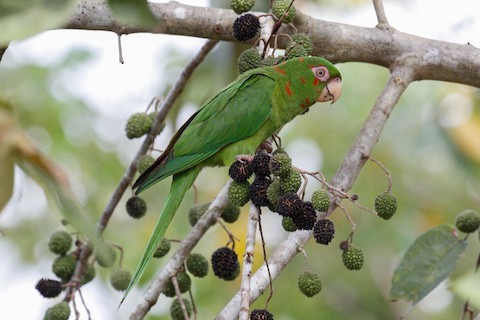Birdfinding.info ⇒ Rare and declining overall, but it remains locally common in the Zapata Swamp area, where it is most readily observed at Bermejas Wildlife Refuge. Other areas where it is still seen consistently include Soplillar, Topes de Collantes National Park, and Finca La Belén.
Cuban Parakeet
Psittacara euops
Endemic to Cuba, where it was formerly widespread, but persecution as an agricultural pest and capture for the pet trade have dramatically reduced its numbers and distribution. Extirpated from the Isle of Youth. Fragmentary remnant populations occur mainly in lowland savannas and some mountain forests. In 2007, its total population was estimated at less than 5,000.
Persists mainly in central Cuba from the Zapata Peninsula east to the Río Cauto delta, with one or two isolated populations in the far southeast. Remaining strongholds include: the Zapata Swamp; savannas of northern Villa Clara; the Sierra de Escambray; savannas of southern Sancti Spíritus and Camagüey; the Sierra de Najasa; the Río Cauto floodplain; the Sierra Cristal; and possibly also the Sierra de Maestra.
Identification
The only wild parakeet in Cuba. Green overall, with irregular flecks of red on the head and sometimes on the breast. Immatures have essentially all-green plumage.
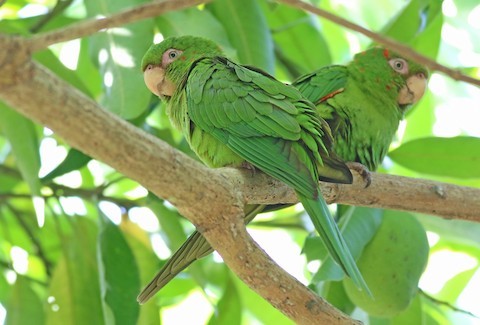
Cuban Parakeets. (Bermejas Wildlife Refuge, Matanzas, Cuba; March 17, 2020.) © Jeremiah Trimble
The bill is ivory-colored. The iris is pale and surrounded by a wide almond-shaped ring of bare, whitish orbital skin.
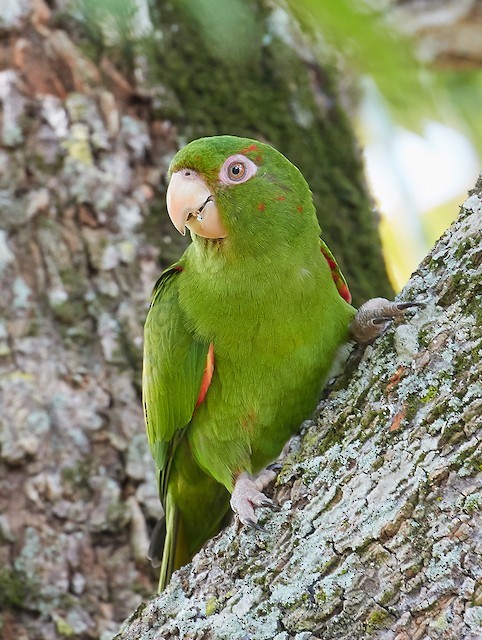
Cuban Parakeet. (Bermejas Wildlife Refuge, Matanzas, Cuba; January 24, 2018.) © Andrew Haffenden
Bright red underwing coverts are conspicuous in flight and usually visible on the front of the folded wing at rest.
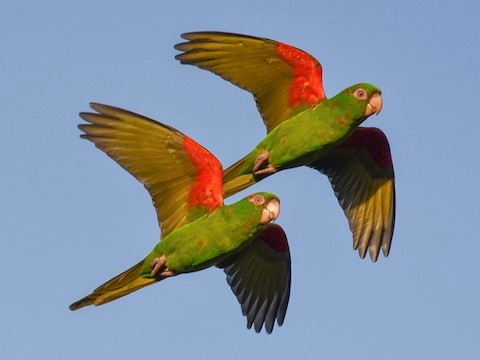
Cuban Parakeets, ventral view in flight, showing red underwing coverts. (Palpite, Matanzas, Cuba; February 24, 2019.) Anonymous eBirder
Immatures resemble adults but with all-green plumage.

Cuban Parakeet, all-green immature. (Bermejas Wildlife Refuge, Matanzas, Cuba; December 2, 2017.) © Knut Hansen
Notes
Monotypic species.
IUCN Red List Status: Vulnerable.
See below for a comparison of the Cuban Parakeet with other Psittacara parakeets.
Cf. Other Psittacara Parakeets. Two other Psittacara parakeets are very similar to the Cuban Parakeet in being green overall with some red in the underwings, and could potentially occur with it due to local releases from captivity. The Hispaniolan Parakeet has nearly identical plumage, but lacks Cuban’s red speckling on the head and breast, has dark eyes, and is somewhat larger. The White-eyed Parakeet—established in southern Florida—is also very similar, usually with irregular flecks of red on its head and breast, but differs in having both red and yellow panels on its underwing coverts, and contrary to the implication of its name, dark eyes.
More Images of the Cuban Parakeet
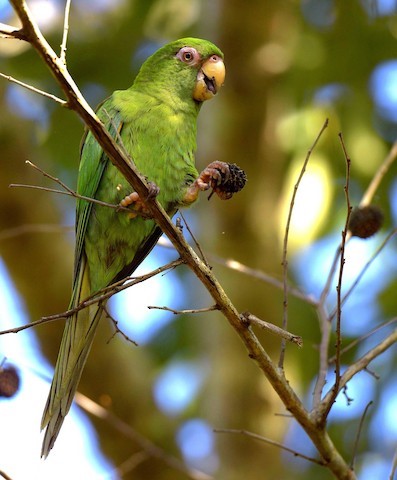
Cuban Parakeet, immature. (Santo Tomás, Ciénaga de Zapata National Park, Matanzas, Cuba; February 24, 2019.) © Paul Arneson
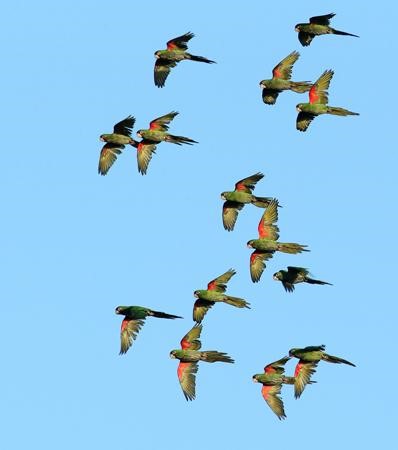
Cuban Parakeet flock in flight, showing red underwing coverts. (Zapata Peninsula, Matanzas, Cuba; December 6, 2014.) © Hal and Kirsten Snyder
References
BirdLife International. 2020. Psittacara euops. The IUCN Red List of Threatened Species 2020: e.T22685690A179593400. https://dx.doi.org/10.2305/IUCN.UK.2020-3.RLTS.T22685690A179593400.en. (Accessed March 8, 2022.)
eBird. 2022. eBird: An online database of bird distribution and abundance. Cornell Lab of Ornithology, Ithaca, N.Y. http://www.ebird.org. (Accessed March 8, 2022.)
Forshaw, J.M. 2010. Parrots of the World. Princeton University Press, Princeton, N.J.
Juniper, T., and M. Parr. 1998. Parrots: A Guide to Parrots of the World. Yale University Press.
Kirwan, G.M., A. Levesque, M. Oberle, and C.J. Sharpe. 2019. Birds of the West Indies. Lynx Edicions, Barcelona.
Navarro, N. 2015. Endemic Birds of Cuba: A Comprehensive Field Guide. Ediciones Nuevos Mundos. Havana.
Raffaele, H., J. Wiley, O. Garrido, A. Keith, and J. Raffaele. 1998. A Guide to the Birds of the West Indies. Princeton University Press.
Xeno-Canto. 2022. Cuban Parakeet – Psittacara euops. https://xeno-canto.org/species/Psittacara-euops. (Accessed March 8, 2022.)
